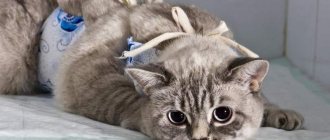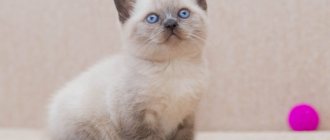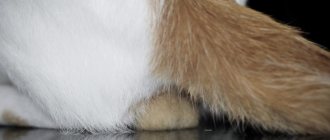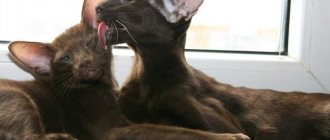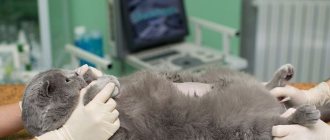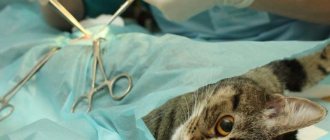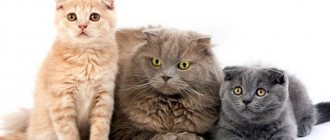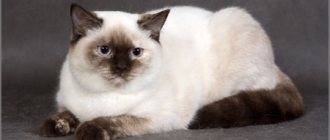For owners of purebred Scots, spaying or neutering their animals is always a difficult choice. For humane reasons, they do not want to inflict pain on their pet; they understand that many years of torture of not satisfying natural needs can affect the physical health of the pet and shorten its life. This is especially true for the castration of the Scottish Fold cat, Scottish Fold, Highland Fold, which have a genetic predisposition to serious diseases of the musculoskeletal system, mating within the breed, which is prohibited.
Veterinary medicine, castration and sterilization technologies have become more gentle and do not harm animals. They, especially cats, return to normal quite quickly after undergoing surgery.
The need for the procedure is also beneficial to the owners themselves:
- Brings relief from the unpleasant odor of urine, which the cat uses to mark its territory during the mating season.
- Saves from periodic, annoying screams and howls of a cat during heat.
When is a Scottish cat neutered?
Veterinarians give clear advice at what age to castrate Scottish kittens - as soon as possible after birth, approximately 10-12 months. This is the optimal age for the operation, when the animal is considered sexually mature, hormones in the body have played a role in development, so there are no contraindications to castration of a Scottish fold cat. The main thing is that the cat is healthy and is examined by a veterinarian.
If a cat is neutered after the experience of mating with a cat, then he may retain the mating process, as well as intuitive memory and behavior.
A Scotsman can and should be castrated at any age, but preferably before the age of 5, when he does not have age-related diseases.
The cost of castration surgery varies depending on the region of the Russian Federation, as well as where it is performed. Calling a veterinarian to your home is convenient for the owner and the cat, but is complicated by special preparations for the site for surgical procedures.
Table No. 1 Approximate cost of castration of cats in different cities of the Russian Federation.
Why do they castrate?
Many people choose a Scottish fold or straight-eared kitten for the soul, because of their love for this breed of cat. Often, breeders themselves neuter pet-class kittens with slight deviations from the standard before sale. This is especially true for Scottish Folds, who are susceptible to genetic diseases due to improper mating.
Unsterilized cats, in the absence of mating, mark the space with stinking urine, during sexual behavior they loudly make terrible sounds and show aggression, which forces the owner to resort to castration surgery.
A conventional operation (orchiectomy), when the testicle in the scrotum needs to be removed, goes quickly. It only takes 15 minutes for the veterinarian to make one small incision, remove the testes, and return the pet to the owner.
Minor complications can arise when you need to castrate, and the kitten is diagnosed with cryptorchidism:
- the ovary-testis is not descended into the scrotum:
- the ovary-testis is located outside the scrotum;
- the ovary-testis is incorrectly located, under the skin in the groin or perineum.
In case of such deviations, the “cryptorchus” operation can be performed in the following ways:
The open method requires surgical intervention with an incision in the place where the ovary-testis is found:
- A more gentle intervention using a puncture, through which the doctor performs all manipulations to remove the ovary and testis.
- Scottish cats should not be fed 5 hours before the operation, because it is performed under anesthesia, and the animal may vomit.
Pet after castration
The entire postoperative period for both straight-eared and fold-eared kittens will last several days and pass without complications. The Scottish cat will need special care on the first day when he recovers from anesthesia:
- be sure to place a sanitary napkin under it; if it is weakened, it may not reach the tray;
- provide a warm place; after surgery, the cat’s internal heat exchange is disrupted;
- Do not place the cat in high places so that it does not fall;
- do not force him to eat, but place him next to a container of water.
After recovering from anesthesia, a well-rested pet will behave as usual. It is important to make sure that he does not lick the incision site. To do this, a postoperative collar is put on him. The wound is treated with an antiseptic for several days.
Childbirth among Scots
Let's look at when and how labor begins in a Scottish Fold cat.
The first signs of labor in a cat are brownish vaginal discharge. The behavior of a cat often changes before giving birth: the animal is looking for a place (nest) to give birth, screaming and making attempts, especially if the Scottish female gives birth to kittens for the first time. In such a situation, it is worth staying close to the cat, calming it down and caressing it, and if necessary, helping, delivering the cat’s birth. Kittens are born head first.
Newborn kittens weigh about 100 grams and are a bubble filled with light yellow liquid. After the kittens are born, the mother chews this bladder, releases the cub and licks it to cleanse the lungs. You can help her with this by suctioning the fluid from her nose with an enema while the female gives birth to other kittens.
Kittens come out at intervals that last about 20 minutes, however, the cat can independently increase the duration of labor and delay the appearance of the babies and carry them for another day if something does not suit her or frightens her. After the young mother has been able to give birth to a kitten, the afterbirth comes out.
Kittens open their eyes a week after birth
All Scottish kittens are born with straight ears, and only at 3 weeks of age should you pay attention to the ears; in folds, they begin to droop
When are Scottish cats neutered?
Sterilization of Scottish cats: Scottish Folds, Scottish Straights, Highland Folds and Highland Straights is carried out at the moment of puberty, which greatly affects the further development of the animal. It matters whether the age at which the operation is performed is too early or too late. Veterinarians consider the optimal development of a Scottish cat for sterilization to be approximately 10-12 months, this is due to the fact that:
The young pet has already grown up enough, is hormonally mature, is able to withstand surgery without complications, and can easily tolerate anesthesia. It speeds up the healing process of skin tissue, which reduces the possibility of infections.
At a more mature age, up to 5 years, postoperative complications and a poor reaction to anesthesia may occur during sterilization. Long-term healing of postoperative suture.
If the cat has had sexual intercourse, then after surgery and removal of the ovaries, she will not be able to give birth, but will retain the function of producing hormones from the pituitary gland and will continue to reproduce in estrus.
Experienced breeders and veterinarians know that sterilization extends the life of a cat to 4 years, which can be explained by the fact that during frequent births a cat loses strength and health to bear kittens, and does not have enough time to recover.
It is difficult to select a purebred Scottish pair, when the fold-eared ones mate - Scottish Folds, Highland Folds with the straight-eared ones - Highland Straights, Scottish Straights. Mating with individuals of other breeds is prohibited; it leads to the birth of out-of-breed kittens. Unfortunately, they often fall into the category of stray animals. Their number will help to reduce castration and street cats as well.
The cost of sterilizing Scottish cats is much higher in the central cities of the Russian Federation, and the price also increases when calling a veterinarian to perform the operation at home. This is convenient for the owner, but more for the pet:
- Moving is always stressful for an animal;
- At home, she will more easily survive post-operative anesthesia;
- In a weakened state, you cannot catch an infection.
Table No. 2: Approximate cost of sterilization of cats in different cities of the Russian Federation
Why is a cat sterilized?
Despite the severity of abdominal sterilization surgery for a Scottish cat, most veterinarians advise performing a medical procedure during puberty that will free the animal from emotional suffering during estrus. Sterilization is especially necessary for Scottish fold cats: Scottish Fold, Highland Fold, mating, which are prohibited due to genetic abnormalities.
The use of special medications temporarily helps, but does not relieve the cat from repeated heats when the dissatisfied animal accumulates surges of hormones. A constant increased accumulation of them in the organs can lead to serious diseases and shorten the life of the pet.
Abdominal surgery is performed under anesthesia, but the cat’s young body can handle it and in 10-14 days, with proper care, the wound will heal.
The operation itself, which allows you to sterilize a cat, is called ovariotomy, and involves removing the ovaries. A more modern method is castration, or ovariohysterectomy, in which not only the ovaries are removed, but also the uterus itself.
Pet after sterilization
After laparoscopy, which is considered a more modern operation, minimally invasive, low-traumatic, the recovery period is shortened, small wounds, fastened with self-absorbable threads, heal quickly with minor treatment.
It is important to know! Laparoscopy is performed under general anesthesia using surgical procedures; three 2mm incisions are used to sterilize the cat. The doctor inserts a small camera into the abdominal cavity, looking at the monitor screen, and removes the uterus and ovaries.
What you need to know when breeding Scots for the first time
Cats
Readiness for the first mating is determined in cats not only when they reach sexual maturity. Considering its delicate characteristics, this breed may show signs of readiness to have offspring as early as 9-10 months, but mating during this period is strictly prohibited. During early pregnancy, a young female may develop serious diseases, and the offspring may even die during childbirth or be born with serious pathologies and abnormalities.
Having reached the age of one and a half years, the cat becomes completely ready for potential mating. The owner only needs to determine the moment of estrus and look for a partner for his cat. But it is necessary to find a truly worthy partner, since estrus in Scottish Straight cats lasts no more than 4-6 days.
Cats
As for Scottish Straight cats, when they reach sexual maturity, they can mate at absolutely any time. They are not at risk of diseases associated with reduced fertility or those that will interfere with their further normal development. Males who have reached the age of 10 months are considered an adult, ready for reproduction.
The peak of increased activity and greatest fertility occurs in males in the spring season. So, the cat begins to behave restlessly, aggressively, begins to call the cat or mark the territory with urine with a characteristic specific smell.
Postoperative care
After the operation in the clinic, the Scottish cat is given to the owner, who is under anesthesia. To provide postoperative care you must:
- transport the animal in a comfortable carrier;
- do not transport an operated cat on public transport, where it can easily pick up an infection;
- at home, allow the pet to freely recover from anesthesia; its duration depends on the drug administered and the cat’s body;
- the cat is placed on the floor, on a warm bedding, which must be changed in time if the cat pees itself;
- If, during the operation, external stitches were placed on the cat’s wounds, then a blanket is put on so that the cat does not reach them with her tongue;
- After the operation, the Scottish woman is not given food. Just put a bowl of water next to it;
- for postoperative constipation, the cat is given a laxative, on the advice of a veterinarian;
- Many people do prescribed intramuscular injections with antibiotics themselves or take their pet to the clinic;
- Wounds are treated with antiseptics twice a day;
- The blanket is removed only after the wounds have completely healed.
Cat food (after surgery)
It is necessary to feed a castrated cat after surgery taking into account his new physiological state, which changes dramatically. He loses interest in cats, and an increased desire for food appears, which is promptly regulated:
- On the first day after the operation, the animal is not fed; it may vomit from the anesthesia; water is placed nearby.
- They think over a diet for natural feeding with an emphasis on protein, fermented milk, ground foods and vegetables.
- With ready-made food, first they give wet food, premium class, designed for neutered cats.
- They feed cats in small portions, do not leave food in bowls, dose the food, and protect the cat from obesity.
- If the kitten is overweight, fasting days are arranged for him.
Cat food (after surgery)
The sterilization operation is difficult for a Scottish cat to tolerate, especially in the first days, until the suture has healed. Subsequently, the cat’s nutrition and behavior will be affected by hormonal imbalances in the body, increased appetite will appear, and metabolism will deteriorate. The owner must follow the rules:
- On the first day after surgery, while the anesthesia is in effect, the cat is not given food. Make sure she drinks water, otherwise dehydration may occur.
- After the operation, to prevent the stitches from coming apart, the castrated cat is fed light pureed food, preventing constipation from occurring.
- Meals should be fractional, in small portions 5-6 times a day, gradually increasing the daily intake to 150 grams.
- A properly formulated diet should contain -35% protein, 35% carbohydrates and 30% fat.
- After the stitches have healed, you can switch to ready-made super-premium food, specially produced for sterilized cats.
- It is necessary to regularly monitor the weight of the Scottish woman; if she deviates from the norm, she is put on a diet.
Conclusion
You need to make a decision about whether your pet will bear offspring or not even before the first heat occurs. But if you want to get offspring from a cat, and nothing more, weigh the pros and cons.
Sterilization can certainly be carried out at any time, especially for medical reasons, but you need to understand that in some situations this approach can lead to serious complications. How ready are you for this?
The questions of whether it is possible to sterilize a cat and what consequences there may be are of concern to many pet lovers, and therefore quite often arise in their minds. Either this arises from personal worries about the animal, or he is illiterate in this matter. But still, there is certain unrest and there is no escape from it.
The culture of sterilizing an animal is very common in Western countries and has not long been considered something out of the ordinary. This procedure is not scary and inhumane, but quite the contrary, it is the only measure to prevent the risk of unplanned offspring in an animal, as well as to preserve its health and especially the health of its reproductive function.
Vaccinations, vaccination schedule and cost
To protect your Scottish pet from infectious diseases, every owner must follow a vaccination schedule from birth until the end of life. It has been scientifically proven that vaccinated animals have a much lower risk of getting infected.
Based on their composition, vaccines are divided into groups:
- Monovalent, capable of protecting against one infection.
- Polyvalent, designed to protect against several diseases.
According to the effect on the body:
- Inactive, easily transportable with a short duration of action, composed of dead viruses.
- Active bacteria that produce immunity contain live bacteria.
Before vaccinating Scottish kittens, they must be properly prepared:
- 2 weeks before vaccination, Scottish kittens are given prophylaxis against helminthiasis using medications recommended by a veterinarian, the dose of which is calculated based on the pet’s live weight.
- Before vaccination, the animal is switched to a lighter diet;
- Vaccination is strictly prohibited for pregnant cats.
Imported vaccines such as Rabizin and Nobivak Rabies are a vaccine against rabies, and Felovax, Purevax for rhinotracheitis, calicivirosis, panleukopenia, are much better tolerated than domestic drugs. The cost of foreign vaccines is more expensive than those produced in the Russian Federation, but they are more effective and have a guaranteed validity period.
Best age for sterilization
The period of puberty in cats differs from other pets. Once a cat reaches 6-9 months of age, it is considered fully sexually mature and can bear viable offspring.
In some cat breeds, due to the characteristics of the body, puberty occurs slightly earlier - at the age of 4.5 - 6 months. This period is characterized by the active release of hormonal substances of the sexual type into the bloodstream - estrogens (produced by the ovaries). Under the influence of a specific hormone, a condition arises that the cat causes anxiety to its owner - it begins to scream heart-rendingly and demand a male, trying to escape from the house.
Depending on the breed and temperament of the animal, the period of increased activity ranges from 2-3 days to 2 weeks. The period is marked by the fact that all organs of the reproductive system are actively preparing for the normal process of conception and further gestation of attached embryos. If the cat does not happen, then the body begins to produce another hormone - progesterone, which is responsible for reducing heat.
Often, animal owners resort to using various tablets and drops that limit the release of hormones in the body, thereby preventing the onset of estrus. Subsequently, pathological conditions such as endometritis, pyometritis, cystic hyperplasia of the uterine walls, and cystic formations on the ovaries arise. You can protect your cat by promptly sterilizing it.
The best age for sterilization is before the first heat. This is the age when the kitten has already reached puberty, but the reproduction process has not yet started. In most cases, the average age at which it is better to sterilize is 6-9 months
It is important to remember that if a cat has already begun to come into heat, you must try to prevent conception.
What vaccinations are given to kittens, cost
Small, helpless kittens receive the first antibodies that increase immunity along with the mother's cat's milk. After weaning, instead of colostrum, the baby needs additional protection of the body from viruses and bacteria. At the age of 8-10 weeks, vaccinations are required for Scottish kittens. Before the first vaccinations are carried out, the kitten is prepared and the body is prevented from worms.
Depending on the conditions of detention and lifestyle, the first vaccination for a Scot contains:
- a vaccine against herpesvirus, calicivirus, panleukopenia and rabies, even if the animal leads a permanent home lifestyle;
- They also vaccinate against viral leukemia and chlamydia if the kitten lives in a private house, in a country house and leaves the house where it has likely contact with other animals;
Vaccinations for fold-eared kittens, as well as straight-eared Scots, are performed in accordance with the following scheme:
- At 2 months, the full range of vaccinations with the exception of the rabies vaccine;
- At 3 months, revaccination is carried out with the same complex of drugs with the addition of rabies vaccine.
- Every year and beyond, as the child grows, the entire vaccination package is repeated, including the anti-rabies drug.
The cost of vaccination depends on the price of the drug and factors of the procedure in different regions of the country and consists of:
- from the cost of the most common complex of drugs: Purevax RCPCh + Rabizin + Nobivac Rabies;
- prices for issuing a veterinary passport;
- payment for the work of a veterinarian;
- payment for calling a doctor to your home.
Adults (what vaccinations are given to adults + cost)
Vaccinations for adult cats and Scottish cats have the following advantages:
- they support the immunity of animals to environmental living conditions.
- Vaccinated pets develop a persistent, throughout the year, resistance to serious diseases;
- The vaccinated animal is protected itself and the owner is guaranteed protection, for example, from rabies;
- The occurrence of some infectious processes in a mild form
- When walking in nature and interacting with other animals, the risk of your pet contracting an infection is reduced to a minimum.
Throughout life, the vaccination procedure is repeated annually, preferably in the same month of the year. They make sure that the animal is dewormed on time, is healthy, and that the cat is not pregnant or nursing cubs.
The basic composition and cost are similar to vaccination for kittens, depending on the region and other factors.
General information about the procedure
Castration of a cat is an operation to remove the testes and suppress the sexual function of the pet.
There are several methods for carrying out the procedure:
- Surgical (or classical). Most cat owners in Russia resort to this method of castration.
- Chemical. A chemical composition is injected into the testes. It destroys the glands, and they are replaced by connective tissue elements. Veterinarians consider this method simple and cheap. However, it has not yet found application in Russia.
- Medical sterilization is the implantation of implants under the skin of a cat. They secrete a drug that completely suppresses the cat’s sexual function. This type of castration is not cheap, but it is absolutely safe for your pet’s health.
- Radiation castration. The cat's testes are placed under a source of gamma radiation to suppress sexual function. The method is reliable, safe for the health of the animal and simple in technique. To carry it out, you will need special equipment, which is not available in all clinics, so the cost of the procedure will be high. Complications are extremely rare. In addition, the cat does not need to undergo either general anesthesia or local anesthesia.
Pros of the operation
Veterinarians believe that this procedure is necessary for animals that will not be used in breeding activities. The owner must study all the advantages of the operation and possible consequences and make an independent decision.
Benefits of the procedure:
- increasing the life expectancy of a pet;
- reducing the risk of developing oncology and diseases of the genitourinary system;
- the pet’s character becomes more balanced;
- getting rid of obsessive and loud meowing;
- cats no longer mark territory;
- suppressing the cat's desire to run away from home in search of a partner.
Negative consequences
During or after the procedure, your pet may experience various complications:
- sudden weight gain due to a slowdown in metabolism in the body;
- development of urolithiasis;
- suture infection;
- pain at the incision site;
- bleeding from the suture;
- disruption of the gastrointestinal tract.
Castration can be fatal, so the operation is prohibited for cats with the following diseases:
- renal failure;
- urolithiasis disease;
- cardiopulmonary failure;
- liver diseases.
Veterinarian tips for caring for your pet
Sterilized cats and neutered cats do not lose, but gain many of the joys of life, and most importantly, their life is extended.
Tip 1 . After the operation, pets are freed from the emotional torment of unsatisfied desires. It is important to remember that the Scottish breed: Scottish Folds, Scottish Straights, Highland Folds and Highland Straights of the pet class are not recommended to be mated either within the breed or with other felines.
Tip 2 . Sterilized cats and female cats have a reduced chance of acquiring urolithiasis, which occurs in many animals due to hormonal surges during “desires” and metabolic disturbances. substances.
Tip 3 . Sterilized animals are prone to overeating; their weight must be constantly monitored. In cases of obesity, switch to a diet.
Selection rules
To choose the right name, you need to get acquainted with the varieties of Scottish cats, how they differ, and the characteristics of each type:
- Scottish Straight, "Scottish Straight", is a short-haired cat with erect ears. They are wide and have pointed tips.
- Highland Straight, "long-haired straight-eared" with wide erect ears.
- The Scottish Fold is a short-haired cat with a special type of ears that are slightly curved inward and resemble a shell.
- Highland Fold is a “long-haired fold” with the same shape of ears, because of their long hair they are completely invisible.
A name is given to a pet once for the entire cat’s life and its choice is carefully chosen so that it is easy to pronounce for the owner and readily accepted by the cat itself. Breeders have developed explanations and basic recommendations on how to name a Scottish kitten for a boy and a girl. The name is given following generally accepted advice:
- Brevity, no more than 2-3 syllables in the name, for example: - Ba-gi-ra; Nu-sha; Ti-ma;
- Euphony, pleasant and easy to pronounce: Lolita (Lola); Penelope (Pepa).
- Memorability of the nickname by the cat itself and all family members, especially small children, for example: Gita; Zita; Natalie (Nata); Peach (Persian); Tata.
- In the nickname it is recommended that the sounds be Ch, Shch, Zh, Sh, Z and S; they are well perceived by the ears of cats and kittens: for example - Zhara Kisa; Gusto; Sonya; Weird guy.
- For Scots, when choosing a name, they additionally take into account:
- For long-haired Highland Straight, fluffy buns, the following is suitable: Chewbacca (furry, Star Wars character)
- For long-haired Highland Folds that look like owlets: Hedwig, that was the name of Harry Potter's owl.
- From external data, especially the muzzle and ears:
- For shorthaired Scottish Straights whose ears are always pricked up: Diana (goddess of the hunt).
- For long-haired Highland Folds, who look like aliens because of their folded, hidden ears: Sirius (constellation), Luntik (planet).
- Depending on the character, nicknames are suitable:
- affectionate: Marshmallow; Lapulya; Chupa Chups
- calm, intelligent: Darling; Mila; Umka (the quiet one from the cartoon).
- playful, nimble: Egoza; Twist (which spins all the time).
- The name dictated at first sight of the kitten.
- For high-breed individuals, the names of Scottish cats are chosen taking into account the names of their ancestors and on the advice of the breeder. Often it is already included in the metric. Owners of pets with complex pedigree names, which consist of several, can reach up to 25 characters, will have to call for example: Laina Magic of the East, the diminutive name Lana.
Choice by appearance
All types of Scottish cat breeds are clearly distinguishable in appearance and are recognizable by the shape of the auricle and the length of the coat. What the Scots have in common is that they are well-built animals with a strong body, a large, owl-like head, bright eyes, most often yellow, and powerful, wide paws. The coat color can be any. In lop-eared animals, diseases are genetically determined by nature: cardiovascular and musculoskeletal.
- Name based on coat color:
- cats: Apricot; Banana; Whiskas; Crow; Grace; Jacquard; Yolk; Lime; Peach; Rubin Uryuk.
- cats: Bagheera; Snow White; Goldie; Dove; Mustard; Toffee; Cinnamon; Turmeric; Lavender;
- By distinctive Scottish origin:
- Cats: Archibald (brave); Maynard (brave); Derek (king of the nation); Richard (brave); Clemens (gracious): Edgar; Edmund (names of the rulers of Scotland).
- Cats: Ariana (purity); Beatrice (traveller); Veronica (giving victory); Daria (symbol of wealth);
- Large kittens are usually called: Atlas (Atli); Grandis (Grand) Titans (Titus).
- Small-sized babies: Baby; Kroshka (Krokha); Slimy (Slim); Bambino (Baby).
- Choice by character. Each Scottish kitten, regardless of the shape of its ears, has its own individual, unique character. Gentle by nature, they will never offend even a bully child. The pet is given a name:
- Good-naturedly:
- cats: - Miron (Mirosha); Quiet (Tisha); Joy; (Joe); Gang; Sandria (Sani);
- cats: - Avilina (Eva); Adelaide (Ada); Barbariska (Barbie); Clare.
- For the mischievous, playful with an explosive temper: - Butuz (Butya); Clyde; Hurricane; Tyson (Tai); Skoda; Shuler (Shulya); Phantom (Phantom).
